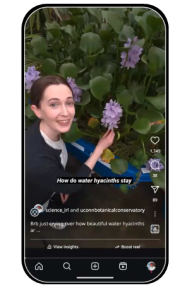 We recently hosted a workshop led by Dr. Molly Edwards, founder of Science IRL Productions LLC, who shared her tips for making short, impactful videos that stand up for science.
We recently hosted a workshop led by Dr. Molly Edwards, founder of Science IRL Productions LLC, who shared her tips for making short, impactful videos that stand up for science.
Molly gave a 20 minute introduction to video creation, which you watch in the video below.
She started with a brief overview of how videos can be used for science communication, which led to a discussion about how these efforts are more necessary than ever in light of current US funding cuts. Molly then proceeded to give suggestions for how a novice can create an engaging video. These included finding a “hook” to grab attention, how to create a story line that builds on that hook, and various ways to illustrate that story, through for example speaking to the camera, showing a set of hands working in the lab or the field, videos captured through a microscope, etc. She also shared a tip sheet with great advice (link).
Molly challenged us to make a short (60 – 90 seconds) video that advocates for science and showcases the impact of research on society.
 To get us started in our own creative journey, we broke into groups to discuss videos with these basic themes: (1) How federal funding has supported my research and career; (2) A day in the life of a scientist; (3) The real-world impact of my research; and (4) Myth busting and fighting misinformation. We shared our ideas about how to grab the attention of the audience in the first few seconds so that they stay engaged, some of the visual techniques we can use to illustrate our story, and what aspects of the creative process we are most excited and nervous about.
To get us started in our own creative journey, we broke into groups to discuss videos with these basic themes: (1) How federal funding has supported my research and career; (2) A day in the life of a scientist; (3) The real-world impact of my research; and (4) Myth busting and fighting misinformation. We shared our ideas about how to grab the attention of the audience in the first few seconds so that they stay engaged, some of the visual techniques we can use to illustrate our story, and what aspects of the creative process we are most excited and nervous about.
We joined together again to ask follow-up questions, paraphrased below.
Q. We talked about how to start a video with a hook, but how do we end it? How can we end it so that people want to learn more?
A. There are so many ways to end a video. You could loop back to the opening hook, make a cute little joke, ask a question of your audience to start a dialogue and encourage engagement, like “Did you like this plant story?” or “What would you like to learn about next?”
Q. Our group talked about the challenge of connecting basic research to things that farmers can use, and getting across the idea that in order to reach an application, a lot of basic research has to take place first. How can we demonstrate that basic research is needed to come up with applications?
A. Great question. Like many of you, my PhD research was in discovery research without a direct application. One way to get people interested is to appeal to their inner nerd. You can share your excitement about something weird and exciting that you are learning about. Like, “Plants do this crazy thing, isn’t it so amazing?” Or, “This is what we’re trying to figure out, and this might lead to increased understanding of pollinator efficiency, or some way we can engineer the shape of a flower to help it be more beneficial for pollinators.” We can make those extra leaps of what might be coming along in the future. I think it is important to make the case for fundamental discovery science, by saying “Everything you use as a farmer has its roots in discovery science”. We couldn’t figure out how to engineer this plant until we understood what these genes and these weird little protein interactions were doing. We couldn’t understand how to fight a plant pathogen until we knew the fundamental mechanisms about how this pathogen gets into the plant. It might be good to have a few examples of how things that farmers are using today have their roots in basic research.
Q. As people who are not very social-media savvy, how can we know what trends to jump on? How can we find the thing that will help us connect to a big audience?
A. I have to admit that I am still getting the hang of this and don’t know how some creators are SO speedy at making videos the second a new meme blows up. There are websites you can search – look for things like “Trending TikTok memes” or “Trending TikTok tags” for example. Or find some creators who do this really well, and keep an eye on them, they will be on top of the trends. I can’t always figure out how to tweak them for a science story, but sometimes I get lucky – I saw the “She doesn’t know it yet” trend that was about unexpected things that happen to people on their journeys, and realized it was perfect for the message I wanted to send about how disruptive the NSF cuts are to my career.
Q. I was thinking about how we’re reading about these tariffs, and a lot of the news is about electronics and stuff, but there’s a big international trade in plant foods, like cacao. So even if we work on a model like Arabidopsis, we can talk about how our research will affect the production of chocolate. As soon as you put a monetary value on it, everyone’s interested.
A. Yes, and we can talk about how funding cuts will affect local communities as well. Help people recognize that these cuts will have a big impact on their everyday lives.
Q. How can we overcome our discomfort about things like appearing on camera? And what about, once you put a video online, not all the reactions will be positive. How do you deal with that?
A. I’m glad you brought that up. When you put yourself out there, you are making yourself potentially vulnerable to some bad actors who like to troll and be unkind on the internet. My foremost piece of advice is to protect your peace and sanity and instantly delete those comments and block them. Delete and block, delete and block. Do not engage. Your video is not going to change their mind. Fighting with them is not going to change their mind. Occasionally I choose chaos and I don’t delete a troll comment on my video and let other people fight it out, which drives up views. I don’t do that often though, and if it gets nasty or cruel or gross I delete it. So my number one piece of advice is delete it, do not internalize it. I’m hoping with this project we are creating a supportive community and a tidal wave of goodness against any weird people that show up.
One strategy for dealing with discomfort in front of the camera is to film with a buddy, just chat and have fun and play together, so you’re not doing this solo and you don’t feel so vulnerable. But if you don’t want to be on camera at all, that’s OK, you can do some animations, or just post a time lapse video of your hands doing something really cool in the lab. We don’t want camera shyness to be a barrier to creating these videos — if it’s a deal breaker for you, that’s totally fine!
Let me share a few final things. We really want you to make something that sparks joy and creativity and fulfillment. This is a heavy time in science. Some of these videos will be like, “Hey, my funding is about to go away”, and that’s heavy and intense. But we hope that these videos are a creative spark, or a way to get you using a creative part of your brain, and that you’re looking forward to making this thing. So that’s the number one goal.
Throughout the week of June 23 we will be releasing our videos, tagged #RootingForScience. Everyone is welcome to join in!
After the Q&A, Molly followed up with a few more tips and resources
I just want to shout out a couple of other amazing resources that I have been finding to be really helpful during this time:
The McClintock Letters, this is a fantastic organization that is coordinating op-ed writing and local newspapers.
Liz Neely (@lizneeley.bsky.social) is one of my SciComm heroes, and she is sending out a weekly newsletter that summarizes the fire hose of information about what is happening in science funding land, and she has really concrete action items to follow as well.
Save NSF is an organization that has just sprung up. They have some great action items for advocating for federal science funding.
And lastly, keep an eye on your scientific societies because they are also coordinating actions, as many of them are facing funding cuts as well.
Additional Links
Profile of Molly Edwards https://www.labxchange.org/library/items/lb:LabXchange:96d677f6:lx_narrative:1
Science IRL YouTube channel https://www.youtube.com/c/ScienceIRL
Tip sheet (link)
0 Comments